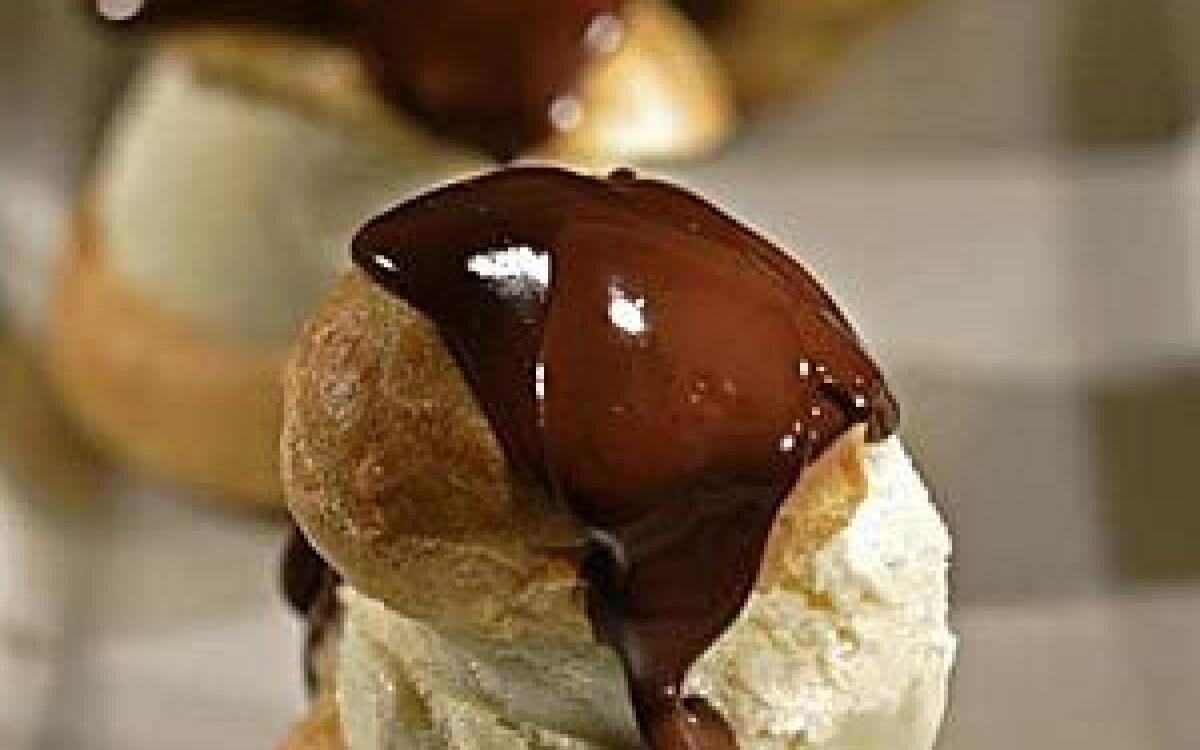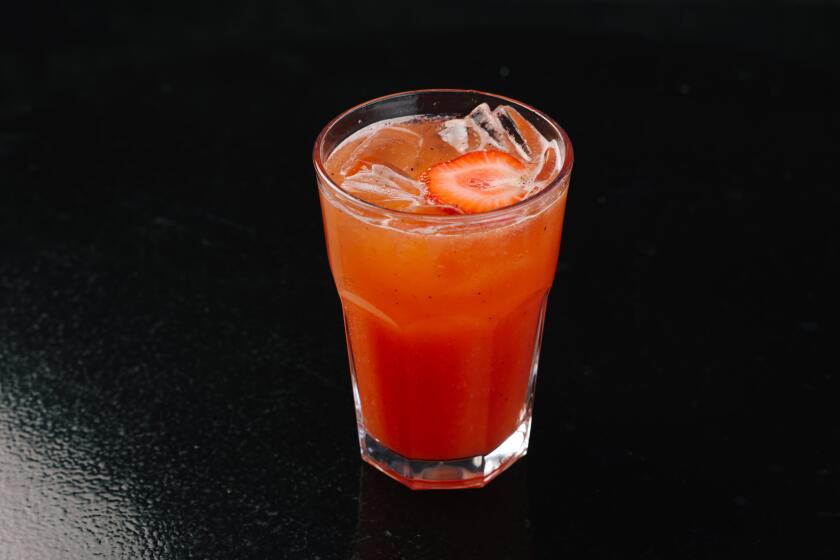Cinnamon-cayenne chocolate sauce

- Share via
Watch rivulets of dark chocolate sauce pour down the curves of a scoop of ice cream or over the low cliffs of a raspberry tart and you get a hint of the transformative power of a good chocolate sauce. Thick and velvety, deeply, sensuously flavorful, such a sauce can dress up a simple dessert or, just in time for the holidays, elevate a great one. It’s pretty good eaten straight with a spoon too.
Years ago, chocolate sauces were made with bricks of baker’s chocolate or cocoa powder, with lots of sugar and vanilla to mask the bitterness, and heavy doses of cream or butter. But now chocolatiers are sourcing cocoa beans “at origin,” just as coffee roasters do, and making bars of chocolate that, like bars of gold, list the percentage of cacao.
Now a sauce is a vehicle for the chocolate, a way of transforming its properties -- solid to liquid -- rather than altering or masking the taste. So making a great sauce is easier than it’s ever been. Just simmer equal parts cream and water, with a touch of salt. Take it off the heat and stir in some broken-up chocolate and a nub of butter (for shine and body and a barely perceptible mellowness) until the sauce is smooth and velvety. That’s it.
With great chocolate, you want a minimalist sauce that depends utterly on the chocolate and showcases its complex flavors.
To start, choose a chocolate with about 70% cacao. Bars in the 70% to 75% range have a wealth of flavor that comes through more clearly than bars with a lower percentage of cacao -- and a higher percentage of sugar. Yet, unlike chocolate with higher percentages of cacao, they don’t need to be sweetened.
(If you’re using a higher percentage of chocolate -- a 75%, say, instead of a 70% -- you may want to add a little more liquid. As chocolates go up in percentage, the increasingly higher proportions of cacao solids make thicker sauces.)
Using equal parts heavy cream and water gives just the right texture: Too much cream and the sauce is a little fatty, whereas all water doesn’t have quite enough body. And although you can use milk instead, cream has a coolness, a slight twang that works well with the chocolate.
And though many chocolate sauce recipes call for vanilla, try making it without. Better to think of it as an optional flavoring. A pinch of salt is a better addition, as it brings out the flavors in the chocolate.
High-quality chocolate can have high citrus notes, maybe hints of raspberry, low echoes of coffee or a register of spice. A good sauce brings these out.
You can play variations on the sauce to your heart’s content.
Use creme fraiche (as many chefs do) instead of part or all of the cream. It gives a little zing, a slightly sour note that complements the flavors of chocolate.
Or add flavorings to the cream-water mixture. Steep tea or citrus zest in it, or a scraped Madagascar vanilla bean, or a handful of crushed espresso beans or hazelnuts. Add a few tablespoons of your favorite liqueur, muddle fresh herbs, throw in a sachet of spices. Flavor the cream with cinnamon and chiles, as the Mayans and Aztecs did, for a little unexpected heat.
Let the mixture steep for 30 minutes. Then strain it if necessary, reheat it -- and add the chocolate just as you would for the basic recipe.
And unlike truffles or cakes, chocolate sauce can be adjusted once you’ve made it. Taste the sauce and if you want to change the flavor or texture, just add to it. Stir in a little more liqueur or extract, some sugar or a hint more cream if you like. If it’s too thick, add water; too thin, warm it up and throw in more chocolate. Because the sauce has a high enough proportion of liquid to chocolate, it won’t seize or separate. In fact, it’s pretty foolproof.
Once you fall in love with a chocolate sauce, you may want to keep a jar of it handy in your refrigerator (where it will keep for weeks). The velvety sauce is amazingly versatile.
Whip some into warmed milk for a cup of morning hot chocolate or a bowl of chocolate soup. Serve it as a dipping sauce with a plate of strawberries; it makes a fantastic simple fondue. Ladle a generous amount over profiteroles, delicate puffs of pate a choux with ice cream hidden inside their hollows.
Or just pour a sauce made from a bar of 71% Ecuadorean chocolate, or a 73% Venezuelan single-bean origin, on your plain bowl of ice cream. You’ll never think chocolate sauce is ordinary again.
In a medium heavy-bottomed saucepan over high heat, bring the cream, salt and one-half cup water to a simmer, stirring occasionally. Just before it starts to boil, turn off the heat. Add the cinnamon and cayenne. Scrape the seeds from the vanilla bean into the mixture and drop in the pod. Cover and allow to steep for 30 minutes. Remove the bean and return the mixture to the heat, bringing it up to a simmer again.
Remove the pan from the heat and add the chocolate and butter, stirring constantly with a wooden spoon to incorporate. Keep stirring until the chocolate and butter melt and the sauce is perfectly smooth. Serve immediately, or reheat when ready to use.
Get our Cooking newsletter
Get a taste of Los Angeles — and the world — with recipes and kitchen tricks from the L.A. Times’ Cooking newsletter.
You may occasionally receive promotional content from the Los Angeles Times.
















